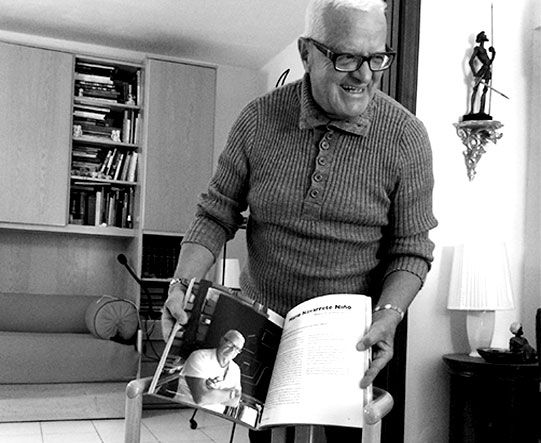- Details

By Erica Kavanagh and Sarah Waller
Photo Courtesy of Erica Kavanagh
FUA builds a cultural bridge between international communities by researching cultural interaction and providing Italian classes to migrant populations.
The group of six students and one researcher were herded into the studio space. The dry, dusty air immediately struck our senses. Countless papers were rolled up into disheveled stacks in the shelves that reached the ceiling. In the middle of this unbelievable room stood an older man speaking 80 percent with his hands as he energetically welcomed us into his world claiming this was “not a mess - this is how you organize for art.”
As he led us into the next floor we left the Florentine culture behind us as we seemed to enter into a new country. With knickknacks resembling another culture next to Florentine mosaics, the mix of Spanish and Italian quickly filled air. Mario Niño Navarrete, a Colombian artist introduced us to his home and workspace. Mario has lived in Florence for 37 years and is the official leader of the Colombian community throughout all of Tuscany. He serves as a mentor for new Colombian migrants and helps guide them through many transitional issues including the immigration process and settling into the Florentine community. As FUA students, we represent the international part of Florence’s society and take on the responsibility to learn about all aspects of the city’s life.
Matteo Pretelli, the lead researcher of FUA’s migrant project "Florence, a Multiethnic Mosaic," hopes to explore how migrants interact with the Florentine community and vice versa. To document the diverse migrant population’s thoughts, experiences and interactions, FUA students from various classes record interviews, take photographs, and interact closely with migrants to better understand the cultural bridges within Florence. In the vibrant Columbian hub of Florence, the FUA students laughed with Mario as he acted out each sentence with a mile-long smile. The similarities, despite language barriers, of the human experience transcended the cultures. The cultural bridge had been built between two diverse groups and understanding is now possible. With the influx in migrants across Europe, specifically Italy, there is a growing need to understand cultural exchange and integration.
The relationship between Florence and migrants is still very young. Within the past few decades, the migrant increase has caused researchers like Pretelli to focus on the awareness of multicultural influence and investigate issues that arise from mixing different cultures. The recurring problem societies typically face when trying to integrate new migrants are the long stemmed stereotypes and the many barriers preventing the interaction between communities. The more knowledge a person has the less likely they are to believe in stereotypes thus creating closer points of contact between diverse people.
The research not only benefits research leaders like Mario and the FUA academic community but helps new immigrants who have yet to learn the Italian language by giving them knowledge in order to promote cultural interaction. FUA has established a close relationship with City Hall and Il Cenacolo to establish a program and plan for Migrants.
In addition to Pretelli’s research project, FUA has started to offer language classes for migrants, two levels offered twice a week on Tuesday and Thursday at sQuola, FUA’s language department. The program improves their language skills and gives them the opportunity to be involved with experiential learning programs. The instructor, Linda Fineschi, is already experienced in this type of teaching, having been involved in a volunteering association to teach italian to the less fortunate. The aims for the new language program is to help migrants integrated successfully into the local florentine community.
By working with the City Hall and Pretelli, FUA creates an international bridge of cultures. The students are connecting with the community in a unique, impactful way to help Florence for years to come; the Italian classes aid the migrants with not only language, but integration into the culture; and the migrants, often without realizing it, shape Florence into the international city that reaches people and transforms them. At the end of this semester, the FUA street photography student volunteers will create an exhibit showcasing the photographs of the migrants, their workspaces and their subcommunities. This exhibit exemplifies the mission of the migrant project. It will bring fellowship by speaking the true language of Florence: Art. The migrant project changes those participating and changes Florence through cultural understanding and acceptance.
Photo caption:
Mario Niño Navarrete, Florentine mosaic artist and Colombian community leader of Tuscany, sharing his achievements with the researcher and volunteers.
